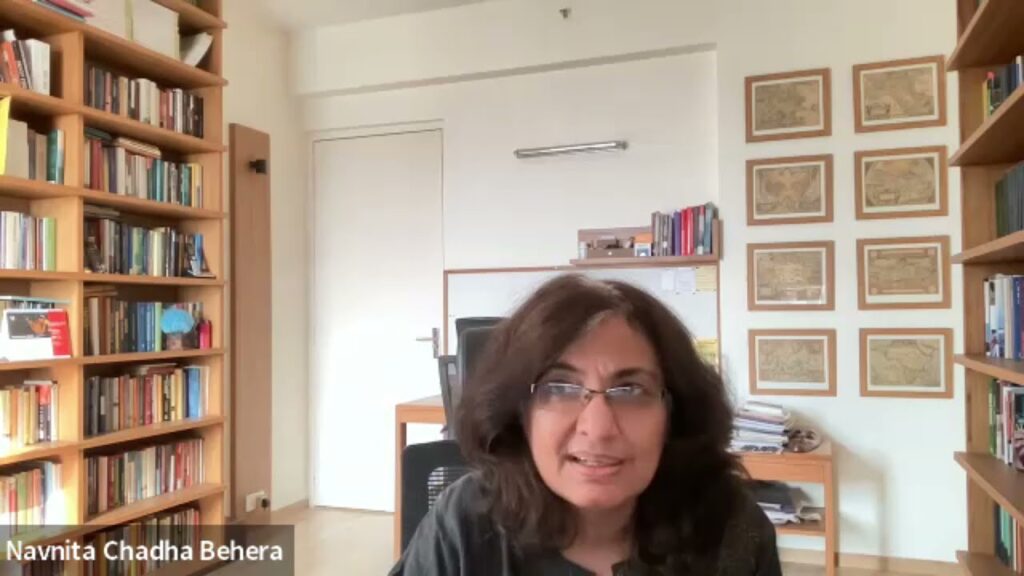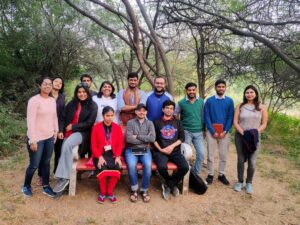
This blog provides discussion highlights for Sunday IR Cafe #15. Conducted on 15th May 2022, the discussion covered Re-imagining IR in India.
Core Arguments:
- Indian international relations theory (IRT) is a distant idea. The conceptualization of IRT in India is limited. To begin with, the traditional Eurocentric IR does not give adequate space to Indian ideas and their historical-philosophical contributions. Further, the disciplinary location and pedagogical constraints have inhibited substantive theorization by Indian IR scholars. In the article, Behera makes an ambitious case for reconceptualizing the notion of what passes as IR to incorporate Indian ways of knowing. The argument is not merely for creating an Indian school within the prevalent IR framework but to fundamentally alter the basis on which IR as a field of knowledge is deemed legitimate.
- Behera’s panoramic overview of the state of Indian IR paints a bleak picture. The disciplinary clubbing of IR under the Political Science and Area Studies department restricts the scope of IR theorization in India. Moreover, the teaching in Indian IR departments primarily focuses on diplomatic histories and India’s foreign relations to the detriment of IR theorization. The lack of funding also plagues Indian IR academia.
- On the issue of the Indian contribution to IR theorization, the opinion is divided between the absence-of-theorization camp and the neglect-of-Indian-theorization camp. The former argues that Indians do not do theory, while the latter holds the power-knowledge nexus responsible for not recognizing India’s theoretical contributions.
- Behera takes the example of non-alignment to support the second camp’s argument. While it is relatively easy to turn Western statecraft practices into IR theory concepts, the practice of non-alignment as an alternative way of ordering the system did not find recognition in the IR canon.
- The author is also critical of the positivist approach to doing IR which, in conjunction with the modernist bias of the discipline, privileges methodological nationalism. In this scheme, India is seen as a nation-state moulded in the Westphalian frame, a conception that does not account for diverse visions of the nation in the Indian context. For Behera, Indian nationalist figures like Aurobindo, Bankim Chatterjee, Savarkar, Gandhi, and Tagore conceptualized nationalism differently, which traditional IR fails to account for. Not only that, in emulating the West in constructing a postcolonial Indian nation-state, the Nehruvian modernist project subjected alternative visions of nation to irrelevance.
- In contrast to traditional IR, new IR theorizations- postcolonialism, feminism, green and queer theorists- take a post-positivist approach; give due space to normative concerns; have scope for culture and identity as variables. For Behera, Indian critiques of Enlightenment modernity, notably Rajni Kothari and Ashis Nandy, also provide a new way of conceptualizing IR.
- Lastly, Behera suggests a three-pronged strategy for re-imagining IR in India- stepping outside the defined boundaries of IR; giving due recognition to everyday life experiences; pushing for the indigenization of academic discourse in IR. Making IR truly post-western does not mean resorting to parochial nativism. Instead, it requires a discussion on what to keep and discard from the heritage of modernity. The post-Western IR theorization would entail a blending of western percepts with non-Western alternative voices. The quest is to create a space for these alternative spaces to emerge by questioning the Western academia’s monopoly in deciding what counts as legitimate knowledge.
Discussion:

- Area studies scholars have been critical of the Eurocentric tendency among mainstream IR theories. Much of the prevalent theorization draws on the Western experiences of state behavior. Such a reductionist analysis risks ignoring a different pattern of state behavior prevalent in other parts of the globe and, in doing so, offers much less to the discipline. Mainstream IR theories, thus, would do well to take area studies seriously by way of using the peculiarities to inform, revise, and reframe the theoretical enterprise.
- However, the way the Area Studies program functions in India and JNU specifically also leaves a lot to be desired. The programs draw underwhelmingly from theoretical canon or contribute to theoretical literature in any meaningful sense. Much of the research work tends to be event-driven or descriptive in nature. The neglect of explanatory analysis comes at the cost of foregoing insights that might have relevance for other areas and IR theories. One notable exception to this trend might be Latin American Studies’ familiarity with the dependency theory.
- On the need for and desirability of an Indian IR, two contrasting positions can be taken. The first position, in the universalist vein, would argue for a deductive approach to theorization that can be applicable across time and space, provided the scope conditions are met. Such an approach would also be comfortable with the positivist epistemology whereby some sort of objectivity can be assumed and knowledge production can be taken to be a detached and unbiased enterprise. However, the critical theorists would contest such an approach to doing IR theory, emphasizing the need for reflexivity and the importance of positionality. In this latter vein, with its interpretivist epistemology, exists some scope for Indian IR school (s) to theorize, based on its particular experience and cosmology. The irony of deploying the interpretivist epistemology, however, is that the methodological boundaries, in this case, are also determined by the knowledge production enterprise in the West. It won’t be difficult to problematise the study of the indigenous phenomenon using supposedly emancipatory but nonetheless western frameworks.
- While non-Western scholars and students may criticize the Eurocentrism of mainstream theorisation, the alternatives also need to be outlined on their part. The Indian IR community’s contribution in this regard can certainly do with more effort. Indian IR Departments have been focused more on foreign policy analysis and do not give due weightage to theory building. Barring a few exceptions, theoretical rigor is missing in the IR department’s teaching curriculum. Unless we come up with alternative theoretical approaches rooted in the Indian knowledge tradition but with widely generalizable explanatory power, mere criticism serves little purpose.
- India’s practise of non-alignment during the Cold War years may serve as a departing point for theorisation based on local experiences. Some may, however, point out that non-alignment should be seen as a foreign policy strategy rather than a theory of international politics. Even so, the concept retains important explanatory power for the decolonised middle power’s conduct in a bipolar system. The theoretical conception of hedging as a strategy can be illustrative here. The inability to explain the behavior of South-East Asian states by way of mainstream IR’s prevalent conception created space for hedging to fill in that gap. Hedging comes close to non-alignment conceptually but also differs in important ways. Further, for any concept to gain prominence, it requires acceptance by the wider community. It is here that Western scholars ought not to be dismissive of ‘outside’ concepts. And, on part of non-Western scholars, the rigor of theorisation need not be sacrificed at the altar of diversity and exceptionalism in meeting the challenge of producing non-Western concepts.
- One way to meaningfully integrate the Area Studies insight into IR theories can be to test the theories based on local experiences. Such an approach need not only serve as the fodder of raw data for western theories but may also falsify the hypothesis to illustrate the limited scope of these theories. The falsification can then serve as a stepping ground to offer corrective explanations in that particular regional context. A good example here would be A P Rana’s approach to the balance of power theory based on his understanding of the Indian context. For Rana, the balance of power would amount to the division of power as the diffusion of power away from the poles would indirectly allow a relative gain in power for India. Rana’s interpretation of the balance of power here differs from western theorisation which equates balance of power as the concentration of capabilities between poles.
- The non-Western IR theorisation will also have to avoid the pitfall of turning the knowledge production enterprise into an instrument of serving the statist power interests. The risk of theorisation’s nativist turn is evident in the concept of Tianxia which can be seen as an attempt to legitimise the Chinese aspirations for ordering the region in a way that serves its interests. During the interwar years, the Japanese vision of Asia for Asians also served a somewhat similar purpose to provide discursive justification for its imperial ambitions. To an extent, similar arguments can be made for the Wilsonian liberal IR theory which rationalises and serves the interest of the U.S. ordering project.
- Beyond the academic dimension of theorisation, the study of IR in India faces several administrative hurdles that impede knowledge production in a meaningful way. Prominent among them is the lack of funding and institutional support for research. In many universities, IR is merely treated as a sub-discipline of political science and the quantitative is glorified over the qualitative. The paucity of adequate jobs with decent salaries adds to the gloom prospect for IR scholars. Even the tangible output produced by the Indian IR community, mostly in form of edited chapters or co-authored pieces, lacks quality in comparison to western academics. Without job prospects and some measure of quality standards in research, it is difficult to be optimistic about the prospect of IR theorisation coming out of the Indian departments.
